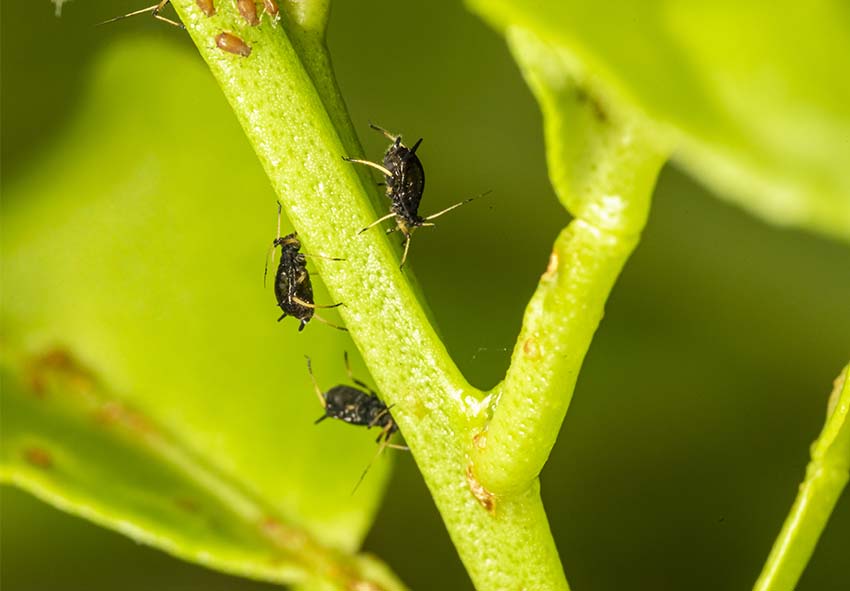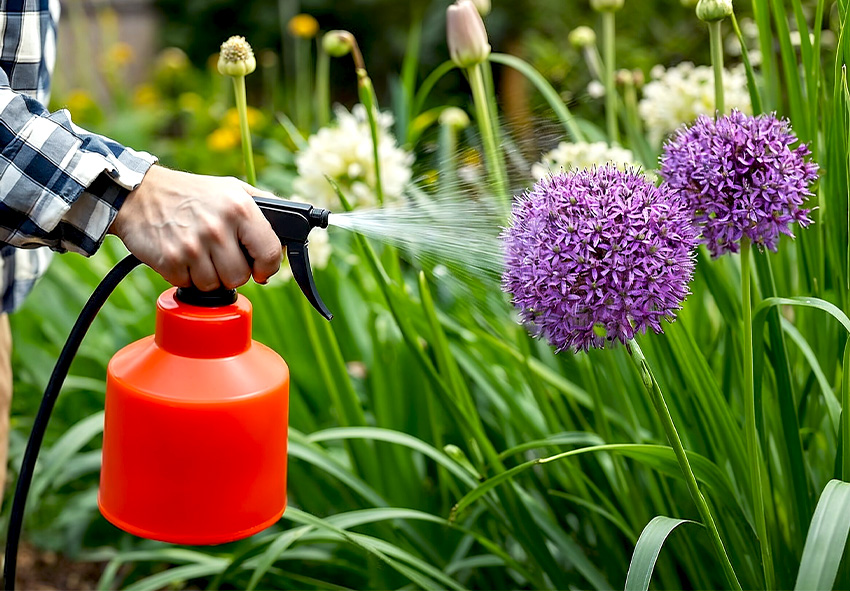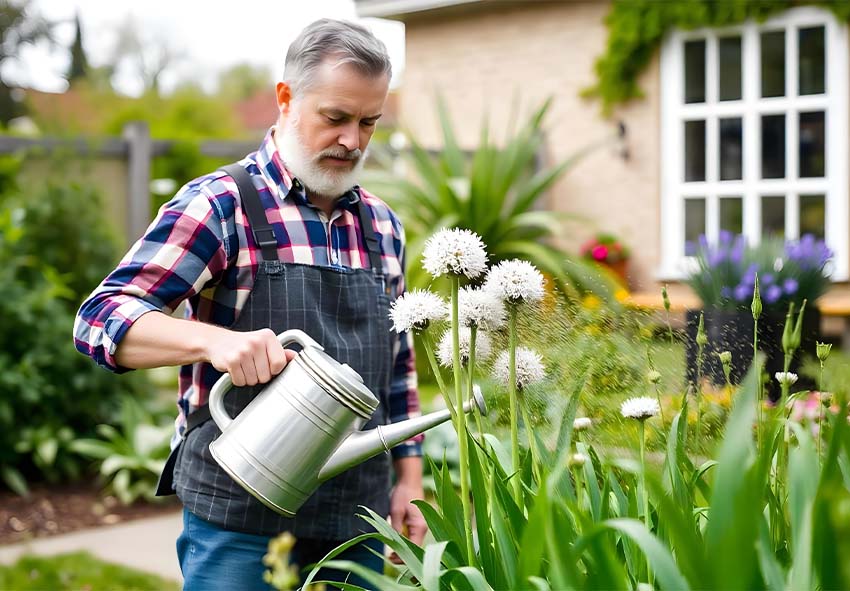Alliums, including onions, garlic, leeks, and ornamental varieties, are prized for their beauty and culinary value. However, they are not immune to pests and diseases that can weaken plants and reduce yields. Understanding common threats and how to manage them is key to keeping your Alliums strong and healthy. With the right prevention and pest control strategies, you can enjoy thriving Allium crops season after season. Our gardening blog is a perfect place to find all the information you need!
Common Allium Pests

Alliums attract a few notorious pests that can quickly harm both foliage and bulbs. If left unchecked, these invaders may cause stunted growth, poor harvests, or even complete crop loss. Let’s explore the most common Allium pests and how to manage them.
Onion Thrips
Onion thrips are tiny insects that feed on Allium leaves, leaving behind silvery streaks or spots. Heavy infestations weaken the plants and reduce bulb size. Regular monitoring and using reflective mulches can help deter them. In severe cases, organic insecticidal soaps can be applied for pest control.
Nematodes in Alliums
Nematodes are microscopic worms that damage bulbs and roots, causing distorted growth and reduced yields. Affected plants may show yellowing leaves and stunted development. The best way to manage nematodes is through crop rotation, soil solarization, and planting resistant varieties. Healthy soil management reduces their impact significantly.
Allium Leaf Miners
Leaf miners burrow into Allium leaves and bulbs, leaving visible tunnels and scars. Their feeding not only weakens the plant but also opens the way for fungal infections. To control them, cover crops with fine mesh netting and remove any infested plant material immediately. Companion planting with strong-scented herbs may also deter them.
Allium Diseases and Their Management
Diseases in Alliums often spread quickly and can wipe out entire crops if not addressed early. Fungal infections are the most common, thriving in damp conditions. By recognizing symptoms early and using proper disease management strategies, you can protect your plants.
Downy Mildew in Alliums
Downy mildew appears as yellow patches on leaves, followed by grayish mold. It thrives in cool, wet conditions and can spread rapidly. To prevent it, ensure proper air circulation, avoid overhead watering, and rotate crops. Fungicidal sprays may be used in severe outbreaks for control.
Neck Rot in Onions and Garlic
Neck rot develops after harvest and storage, often caused by high moisture levels. Affected bulbs become soft and emit an unpleasant odor. To manage neck rot, harvest Alliums in dry weather and cure bulbs thoroughly before storage. Storing in a cool, well-ventilated area helps prevent fungal spread.
White Rot in Alliums
White rot is a serious soil-borne disease that causes plants to wilt and bulbs to rot. It spreads through fungal spores that can survive in the soil for years. Once detected, it’s crucial to remove affected plants and treat the soil. Crop rotation and soil health management are essential for long-term control.
Prevention and Pest Control for Alliums
The best way to keep Alliums healthy is by focusing on prevention rather than treatment. Good gardening practices reduce the risk of pest infestations and disease outbreaks. Here are some effective prevention strategies for Allium pest and disease control.
Crop Rotation and Soil Health
Rotating Alliums with unrelated crops helps prevent soil-borne diseases like white rot and nematodes. Healthy, well-drained soil supports stronger plants that can resist pests naturally. Adding organic matter also boosts soil fertility and reduces stress on Alliums.
Proper Watering and Spacing
Overwatering creates damp conditions that favor fungal growth. Water your Alliums at the base of the plant and allow the soil surface to dry between watering. Adequate spacing between plants improves airflow, helping to reduce disease risk.
Natural Pest Control for Alliums

Alliums are generally hardy plants, but they can still fall prey to pests like onion flies, thrips, and nematodes. Instead of relying on chemicals, natural pest control methods offer an eco-friendly way to protect your plants while maintaining soil health and biodiversity. Below are effective natural strategies to keep your alliums thriving:
- Companion Planting – Plant herbs like mint or chamomile nearby to repel common pests naturally.
- Neem Oil Spray – A safe, organic solution that disrupts pest feeding and reproduction cycles.
- Garlic Spray – Homemade garlic sprays deter thrips and aphids effectively without harming the plants.
- Encourage Beneficial Insects – Ladybugs and lacewings prey on pests that damage alliums.
- Crop Rotation – Changing planting locations yearly prevents pest build-up in the soil.
Long-Term Disease Maintenance for Alliums
Preventing and controlling Allium diseases isn’t just about treating symptoms—it requires a long-term maintenance strategy. Proper soil care, resistant varieties, and hygienic practices will ensure your Alliums stay healthy year after year. Here are some essential ways to maintain disease control in the long run.
Soil Treatment and Sanitation
Soil is the most common source of recurring Allium diseases. Regular treatment and cleanliness help reduce disease pressure.
Key practices include:
- Remove and destroy any infected plant material immediately.
- Use soil solarization in summer to kill fungal spores.
- Avoid planting Alliums in the same spot for at least 3–4 years.
Choosing Resistant Varieties
Some Allium varieties show stronger natural resistance to certain diseases. Planting these reduces the risk of outbreaks.
Examples include:
- Onions bred for downy mildew resistance.
- Garlic cultivars less prone to white rot.
- Ornamental Alliums that thrive in drier soil conditions.
Hygiene and Garden Practices
Good hygiene goes a long way in preventing Allium diseases from spreading. Simple habits keep your plants healthier.
Maintenance tips:
- Disinfect tools after working with infected plants.
- Keep the garden free of weeds that may harbor pests and diseases.
- Store harvested bulbs in clean, dry conditions
Seasonal Maintenance for Healthy Alliums

Year-round maintenance plays a vital role in keeping Alliums free from pests and diseases. Simple seasonal steps can help protect plants from both growing-season threats and post-harvest issues. A consistent routine ensures strong bulbs and abundant blooms or harvests.
During the growing season, inspect plants regularly for signs of infestation or disease. Remove any damaged leaves to prevent spread. After harvest, store bulbs in a dry, cool place and check them frequently for signs of rot. This seasonal care helps maintain the health and longevity of your Alliums. Check out our full guide for Alliums for more useful caring tips.
Conclusion
Allium pests and diseases can be challenging, but with early detection and prevention, they don’t have to threaten your garden. By practicing crop rotation, proper watering, and natural pest control, you can protect your onions, garlic, leeks, and ornamental Alliums. Healthy plants not only resist pests better but also reward you with strong harvests and stunning blooms!
Frequently Asked Questions (FAQs) about Allium Pests and Diseases
1. What are the most common pests affecting alliums?
The most common pests are onion flies, thrips, and nematodes. These insects attack bulbs, stems, and leaves, weakening the plants. Regular inspections, natural sprays like neem oil, and companion planting can help control them. Preventive care is always better than dealing with a full infestation.
2. How can I recognize disease symptoms in alliums?
Signs of disease include yellowing leaves, stunted growth, mold on bulbs, or soft, rotten tissue. Fungal issues like downy mildew and botrytis are common. By practicing crop rotation and avoiding overwatering, gardeners can greatly reduce the risk of such infections developing in their alliums.
3. Are natural pest control methods effective for alliums?
Yes, natural methods such as neem oil sprays, garlic sprays, and encouraging beneficial insects are highly effective. These solutions work by either repelling or reducing pest populations while protecting the ecosystem. They are also safe for edible plants and help maintain healthy soil.
4. Can I order Allium bulbs from your online store?
Yes, you can! Our online store Dutch-bulbs.com offers a wide selection of Allium plants, including different varieties and colors. We take pride in providing top-quality plants that are carefully cultivated and shipped with care to ensure they reach you in perfect condition. Our plants can be a wonderful addition to your home or garden.
5. How can I prevent pests and diseases in my allium crop?
Prevention starts with healthy planting practices like crop rotation, proper spacing, and selecting disease-resistant varieties. Adding mulch to regulate moisture, avoiding overcrowding, and monitoring plants regularly can help. Using natural pest deterrents ensures long-term protection without relying on harsh chemicals.
Published: 12.09.2025
